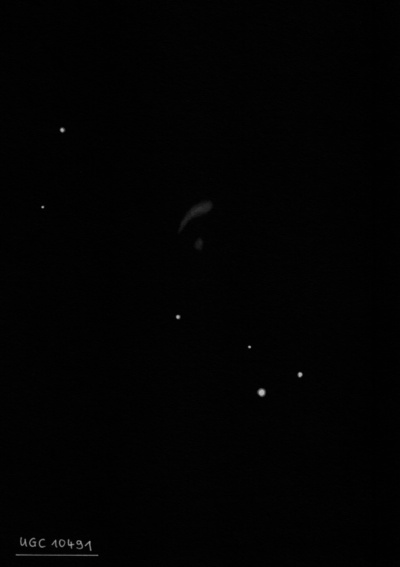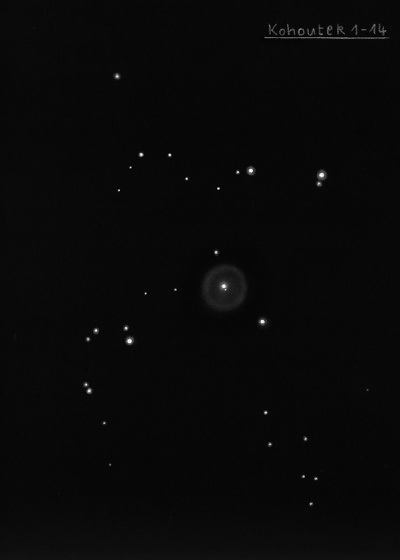A large constellation of the northern sky typical of summer evenings, the northern part of which is circumpolar in our latitudes. Hercules is found roughly in a triangle, the vertices of which are Vega of Lyra, Ras Alhague of Hadonos, and Gemma of the Northern Crown. In the eastern part of the constellation, towards the star ν Her, is the apex - the point to which the Sun approaches in relation to the surrounding stars. It was discovered in 1783 by William Herschel on a relatively small set of stars. The speed at which the Sun moves towards the apex relative to the surrounding stars is nearly 20 km/s.
Hercules occupies an impressive area of the sky and, despite the fact that it doesn't have a single bright star, it is quite striking. The body of Hercules is marked by four stars: ε, ζ, η and π Hercules, which form a quadrilateral called a "flowerpot". From it, then, the individual chains of stars radiate out to the southwest and southeast, as well as to the northwest and northeast. On the western side of the flowerpot, at about 2/3 of the distance between ζ and η Hercules, lies the brightest globular cluster in the northern sky, M13, visible to the naked eye under favourable conditions. Also worthy of attention are another globular cluster, M92, and the pretty blue-green planetary NGC 6210, several colourful binaries and many galaxies, most of which belong to the outlying Hercules galaxy cluster designated C1 0024 - 1654. It is the densest known cluster, with up to 70 galaxies per square degree in its central regions.
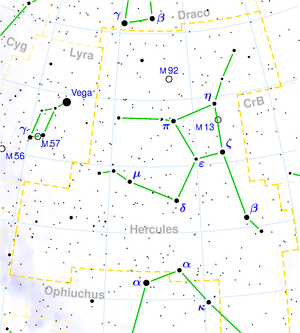
ζ Her - A nice double star in the "Flowerpot". The components have magnitudes of 2.9mag and 5.5mag and are approximately 1.6" apart. Since their orbital period is only 34.5 years, the positional angle and separation change rapidly.
δ Her - A well-known optical double star, whose pale blue components exhibit completely different proper motions, resulting in a relatively significant change in their mutual position over time. In 1830, their mutual separation was 26", but by 1960 they had approached each other to a distance of only 9", and since then their separation has gradually increased again. The primary star has a magnitude of 3.1 and the companion has a magnitude of 8.2. To resolve this rare pair, a telescope with a 6 cm objective diameter will suffice.
μ Her - The main and conspicuously yellow component with a brightness of 3.4 magnitude has a companion of 10th stellar magnitude, which is actually composed of two red dwarfs.
Ras Algethi (α Her) - A significantly red star is located near the border with Hadonoš, a supergiant whose brightness irregularly varies between 3.1 mag and 3.9 mag, often only between 3.3 mag and 3.7 mag. The period is 90 to 100 days. Suitable comparison stars are ι and κ Ophiuchi, which are located about 6.5 degrees to the southwest and have a brightness of 4.3 mag and 3.2 mag, respectively. Alpha Herculis is also a binary star, with its second component of fifth magnitude located 4.7" away, visible even in small telescopes with a 6 cm objective diameter. It has a greenish tint that nicely contrasts with the red giant.
68 Her - An eclipsing binary star. They are actually two strongly flattened, almost equally sized stars that orbit each other in 2.051 days. As a result, we observe light changes of 68 Her from 4.7 mag to 5.4 mag. The brightness of both stars is quite different. The brighter one is 260 times more luminous than the Sun and the weaker one is only 100 times. Their mass reaches 7.5 times and 2.9 times the mass of the Sun. In terms of size, both stars exceed the diameter of the Sun by about 6 times.
Marfak (κ Her) - A physical binary star, whose yellow components with magnitudes of 5.3 and 6.5 are separated by 28.4", and therefore can be resolved even in small telescopes. 36" to the SSW there is another companion with a magnitude of 13.6.
36/37 Her - Two ordinary close stars, which can be distinguished even with a hand lens. They are located on the southwestern edge of the constellation at a mutual distance of 70" and their brightness is 5.7 mag and 6.8 mag, respectively.
M 13
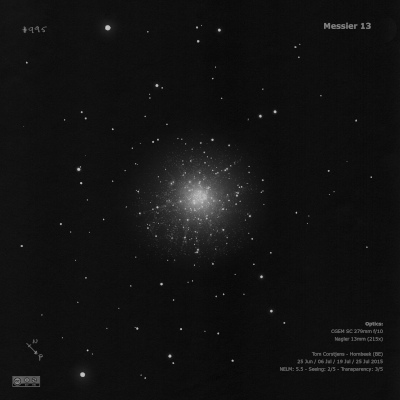
Edmond Halley discovered M13 = NGC 6205 = h1968 in 1714 with a 24-foot (focal length) refractor. He noted "This is but a little Patch, but it shews itself to the naked eye, when the sky is serene and the Moon absent." Charles Messier independently found the cluster on 1 Jun 1764 and reported (first Messier catalogue), "I have discovered a nebula in the girdle of Hercules, of which I am sure it doesn't contain any star; having examined it with a Newtonian telescope of four feet and a half [FL], which magnified 60 times, it is round, beautiful & brilliant, the center brighter than the borders.."
M13 was probably the second deep-sky object that William Herschel observed (after the Orion Nebula) before starting his sweeps. Using a 6-inch (7-ft focal length) on 22 Aug 1779 he noted M13 was "without stars". On 16 May 1787 (sweep 739 with his 18.7-inch) he recorded, "a most beautiful cluster of stars, exceedingly compressed in the middle and very rich, the scattered stars which belong to it extend to 8 or 9' diam. The most compressed part about 2' or 2 1/2'; the later is R. The former more irregular."
William Parsons (LdR), in his 1850 monograph, noted "an unquestionable curvilinear sweep in the disposition of the exterior stars." Bond later "confirmed" this spiral structure (seems a case of imagining spiral arrangements in deep sky objects, which was common at the time) in 1860. Bindon Stoney sketch on 26 May 1851 (includied in the 1861 publication) clearly showed three dark "lanes"in a "Y" configuration. The dark lanes, sometimes referred to as the "propeller" nowadays, were mentioned in numerous observations with the 72". Mark Harrington, director of the Detroit Observatory in Ann Arbor, made a study of the dark rifts for a month in 1887 with the 6" and 12.5" refractors. Comparing Stoney's sketch with his observations and a drawing made with the aid of H.C. Markham, Harrington mistakenly concluded the rifts "have shifted their position slightly" since Stoney's drawing.
200/250mm - 8" very bright, very large, round, highly resolved into several hundred stars mag 11.5-13.5 over the entire disc. Includes several star chains and streamers.
400/500mm - 17.5" (7/9/94): several hundred stars in a 10'-12' diameter with a bright central core of 6' diameter. Many stars are arranged in strings and loops including a distinctive streamer attached on the SE side which heads south and curves west forming a semicircle and another string is attached on the west side of the core and precedes the cluster. Several chains of stars are also resolved over the 6' core. Running along the north edge of the core is a starless strip or a long dark lane which separates the central region from the northern outer halo members. A dark "lane" protrudes into the core on the SE side - this is one of three dark lanes that converge forming a "Y" and referred to as the "Propeller" (first described by Lord Rosse). NGC 6207 lies 28' NE and extremely faint IC 4617 lies 14' NNE. HD 150998, a mag 6.8 orange K2 star, lies 17' ENE of center.
Naked-eye - fairly easy object in a dark sky, appearing as a dim bloated star.
Notes by Steve Gottlieb
M 92
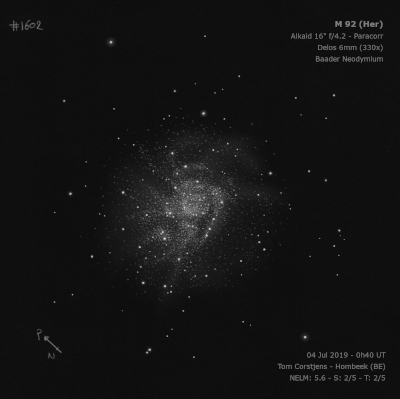
Johann Bode discovered M92 = NGC 6341 on 27 Dec 1777. Charles Messier independently rediscovered M92 on 18 Mar 1781. WH's earliest observation was on 25 Aug 1783 using his 12-inch, calling it "A most beautiful sight. I can count 50 or 60 stars besides numberless that only distinguish themselves by twinkling..." JH has no observations listed in his Slough Catalogue. Christian Peters reported finding it around 1850, while at Capodimonte Observatory in Naples and claimed it did not appear in any of the books.
200/250mm - 8" (7/9/80): very bright, moderately large. Well resolved into many long streamers from the small bright nucleus and some core resolution.
300/350mm - 13.1" (6/29/84): highly resolution over entire disc, dozens of stars resolved in bright core. A bright knot in the core is partially resolved at 416x.
400/500mm - 17.5" very bright, large, very high resolution of 150-200 stars many in curving lanes. A tight knot of stars in the core is resolved.
Notes by Steve Gottlieb
NGC 6210
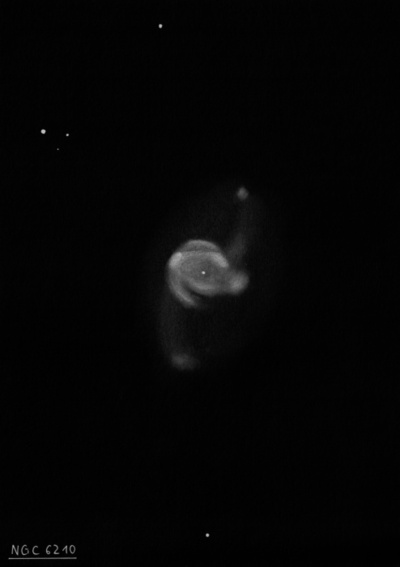
Wilhelm Struve discovered NGC 6210 = ∑ 5 = h1970 in 1825 while searching for double stars with the 9.6" Fraunhofer refractor at the Dorpat Observatory in Estonia. It was included as #5 in a list of 9 "Nebulae dectae" in an appendix to his main catalogue of double stars published in 1827. He described a "bright planetary nebula, diameter 6", like a star of mag 7". The planetary was earlier catalogued as a star in Lalande's catalogue of 1801 (LL 30510).
John Herschel observed the nebula on 25 May 1830 and recorded, "Struve's fifth nebula, very bright, equal to a star of 8 to 9m, 6" diameter and of uniform light, but with the edges boiling and ragged. A fine object like a star out of focus". Vogel observed and sketched the central star with the 27" Grubb refractor at the Vienna observatory on 4 Jun 1883. He noted a "Bright planetary nebula of elliptical shape. A delicate star is in the nebula, nearly at the centre. The nebula is surrounded by a faint elliptical shell."
On 5 May 1850, Johnstone Stoney, Lord Rosse's assistant, recorded, "intense blue centre fading off to some distance all around. Small star nf to which neb nearly extends. Fancied a projection from the bright centre towards np, but I think it was only fancy." It is possible, though, that Rosse detected the wing or extension to the northwest! James Keeler clearly sketched the wings using the Lick 36-inch refractor.
Sherburne Burnham observed the planetary in 1891 while at Lick Observatory, but did not notice the central star. Later at Yerkes (1908) he commented, "At the present time it could not be overlooked with any moderate aperture. It is nearly 12th magnitude, and appears with favorable atmospheric conditions as a sharp, brilliant point. Doubtless this has been seen by others. If it is not variable, I cannount account for my failure to see and measure it with the 36-inch at Mt. Hamilton.
Based on Crossley photographs at Lick, Curtis (1918) reported, "Central star about mag 11, surrounded by bright matter in the form of an oblong 8" in length. Outside of this is an oblong of somewhat fainter matter 20" X 13", from the ends of which extend two fainter ansae in p.a. 97-277°. From the north and south sides of the central oblong extend two longer ansae in p.a. 167-347°, showing a ring formation, making the nebula 43" long in this direction."
Wolfgang Steinicke explained why William Herschel missed NGC 6210 in his sweeps: "On 15 May 1784 he swept the region (sweep 217). However he stopped for about 30 minutes for star counts, i.e. the sky passed horizontally through the eyepiece. Unfortunately the strip runs about 1° below the nebula, starting 25 tmin west and ending 6 tmin east of it. Thus the object could not enter his field of view (15'). On 10 April 1785 he inspected the field again (sweep 395), but saw only some Flamsteed stars in the morning twilight."
300/350mm - 13.1" (7/5/83): very bright, extremely high surface brightness, blue, takes very high power. The mag 12.6 central star was not seen.
400/500mm - 17.5" (5/27/00): beautiful bluish oval at 220x, elongated 4:3 E-W, roughly 24"x18". At 380x, there appears to be a very small fainter halo. At 500x, the narrow outer envelope is more evident and is elongated in the direction of the major axis, increasing the size to ~30"x20".
17.5" (7/4/86): very bright, small blue oval 20"x15" with an unusually high surface brightness. At 572x, a fainter outer envelope is suspected. An evenly matched close double star ∑2094 = 7.4/7.7 at 1.3" lies 17' SSW.
600/800mm - 28" (7/8/13): viewed at 375x with an "inverse OIII" or central star filter, which dramatically dimmed this extremely high surface brightness green planetary. Without the filter the central star was not seen at this magnification (the planetary had a strong green color), but with the filter the central star was easily visible!
900/1200mm - 48" (5/5/16): at 488x; extremely bright, high surface brightness planetary, oval 5:4 WSW-ENE, somewhat rectangular main body. The central star was continuously visible and situated slightly east of center. A small darker region surrounds the central star. On close inspection the main body has an irregular outline, is slightly brighter along the north side and bulges out on the southwest end. A thin fainter "strip" or shell with a much lower surface brightness and a pinkish color encases the main body. Two or three broad "jets" or wings (broadest at the base) extend out of the halo on the north and south ends (images show the central part is NNW and SSE) with the northern wing more obvious. A third wing was sometimes visible on the west side.
Notes by Steve Gottlieb
NGC 6229
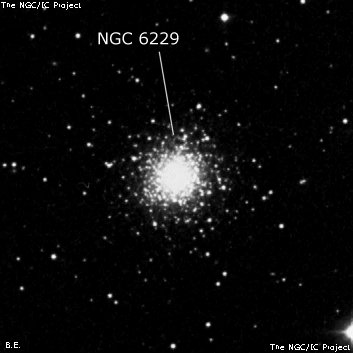
William Herschel discovered NGC 6229 = H IV-50 on 12 May 1787 (sweep 735) and recorded "vB, R, about 4' dia. The whole of it is almost equally bright with a faint, resolvable margin." It was misclassified as a planetary nebula (class IV). CH's reduced position is 4'-5' too far north. Giuseppe Bianchi independently found this globular on 11 Jun 1839 and announced the discovery in an AN letter, apparently unaware of WH's prior discovery.
400/500mm - 17.5" bright, fairly small, very bright core, faint mottled halo. Roughly 10 extremely faint mag 15-16 stars are resolved around the edges of the halo at 280x. Forms an equilateral triangle with two mag 8 stars 6' W and 6' SW.
Notes by Steve Gottlieb
NGC 6058
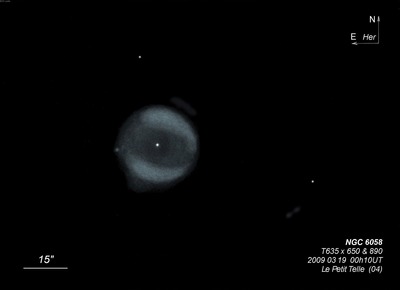
William Herschel discovered NGC 6058 = H III-637 = h1946 on 18 Mar 1787 (sweep 718) and recorded "vF, eS, 300 showed 2 very close stars affected with nebulosity, a very small star in the field with it was perfectly free from that nebulosity." John Herschel made two observations on consecutive sweeps and noted "pB, vS, R, almost stellar or psbM; diam 10"."
George Johnstone Stoney, Lord Rosse's assistant on 5 May 1850, wrote "strongly suspect to be an annular neb with a star near the center. On 5 Apr 1851, his brother Bindon wrote, "like [NGC 2392], dark ring plainer seen on preceding part of neb; vS * north, about 3/4' diam of neb off. The following part of dark ring a little broader than the preceding part." Samuel Hunter made a sketch on 9 May 1861 and this was included at the last minute in the 1861 publication.
The spectrum was recognized as a PN by Campbell and Moore. Based on a Crossley photograph at Lick, Curtis (1918) reported "an irregular oval fading out at ends of major axis, brightest at north and south edges; 25"x20" in pa 77°."
200/250mm - 8" (7/5/83): at 100x, faint, very small, round, even surface brightness. At 200x, an extremely faint mag 13.5-14 central star is visible surrounded by a small faint halo. Two mag 9 stars to the north form an rough isosceles triangle.
300/350mm - 13.1" (7/5/83): fairly faint, small. Fairly easy central star at 166x, two stars to the north form an equilateral triangle. Can take 333x.
400/500mm - 17.5" (5/27/00): fairly bright, fairly small, slightly elongated NNW-SSE, 25"x20". Contains an easy mag 13.5 central star, which stands out well at all powers. At 380x, the halo appears to brighten surrounding the central star. Nicely framed within a triangle of mag 9-10 stars.
17.5" (5/30/92): fairly bright, small, 20" diameter. A bright mag 13 central star is easily visible. Located within a bright isosceles triangle consisting of mag 8.8 SAO 45874 4.8' NW, mag 8.7 SAO 45881 6.3' NE and a mag 10 star 3.5' S.
600/800mm - 24" (7/14/18): at 375x; bright mag 13 central star encased in a well defined 0.4' halo. At 500x the halo is clearly elongated N-S, ~25"x20", slightly fainter at north and south end. A very faint mag 15.9 star is close off the north edge.
Notes by Steve Gottlieb
IC 4593
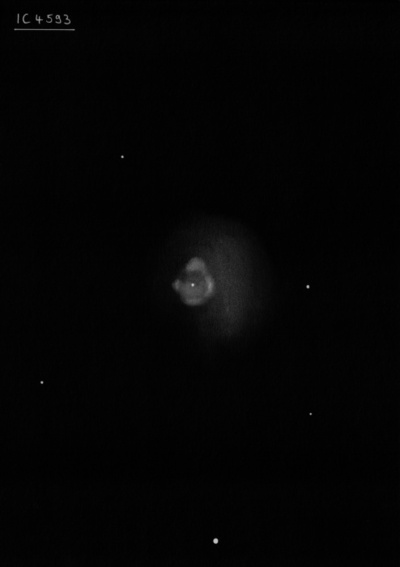
Williamina Fleming discovered IC 4593 = Fleming 96 in 1907 on a Harvard objective prism plate. Based on Crossley photographs, Curtis (1918) described, "Central star about mag 10. This is surrounded by a disk of brighter matter 11" in diameter, fading out a little towards the edges. There is a bright wing at the north end in pa 347°, and a smaller and fainter projection opposite this; fainter matter outside brings the whole diameter to about 15"."
The Catalogue of Galactic Planetary Nebula, Sky Catalogue 2000.0 and the first edition of the Uranometria 2000.0 Atlas has the wrong RA of 16h 12.2m. At this position on the U2000 is a mag 9 star as IC 4593 was recorded as a star in the BD catalogue.
John Mallas coined the nickname "White-Eyed Pea" in his Feb/Mar 1963 article "Visual Atlas of Planetary Nebulae-III", published in the "Review of Popular Astronomy".
200/250mm - 8" (6/81): stellar at 100x but a slightly elongated disc is easy to view at 220x-350x. Located 12' NW of a mag 9 star.
400/500mm - 17.5" (5/10/86): at 286x a bright 11th magnitude central star is visible surrounded by a small, slightly elongated halo, bluish color. Located 11' NW of double star ∑2016 = 8.6/10.0 at 7". Incorrect position given in Sky Cat 2000 and plotted at the wrong position on U2000.
Notes by Steve Gottlieb
NGC 6207
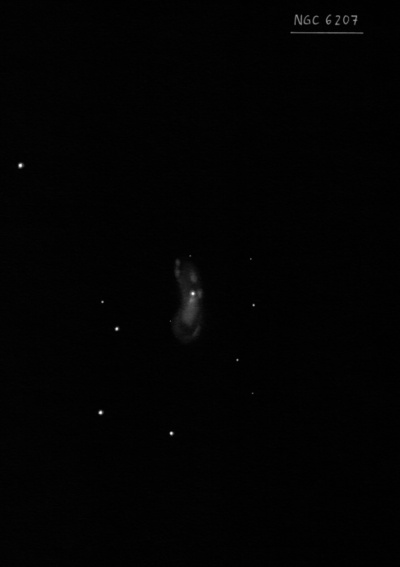
William Herschel discovered NGC 6207 = H II-701 = h1969 on 16 May 1787 (sweep 739) and recorded "pB, pS, E from sp to nf, vgmbM."
300/350mm - 13.1" (8/5/83): moderately bright and large, elongated SSW-NNE.
400/500mm - 17.5" (6/6/86): fairly bright, very elongated 3:1 SSW-NNE, bright stellar nucleus, possible asymmetric appearance. Located 28' NE of M13. The noted stellar nucleus is likely a superimposed 13th magnitude foreground star.
600/800mm - 24" (6/16/12): fairly bright, fairly large, elongated 5:2 NNW-SSE, sharply concentrated with a very small bright core. A blazing stellar nucleus is apparently a superimposed star. The outer extensions clearly have an irregular surface brightness and an asymmetric appearance.
Notes by Steve Gottlieb
NGC 6484
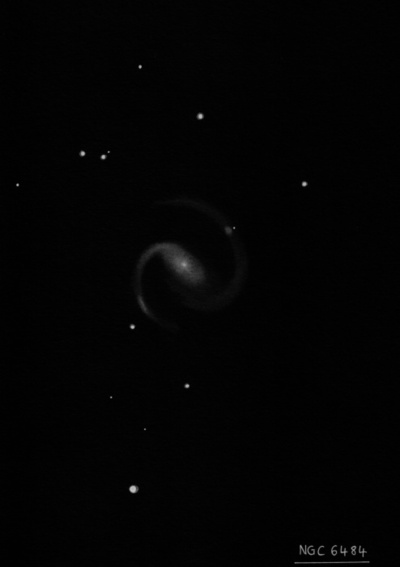
Truman Safford discovered NGC 6484 = Sf 41 = St VII-19 on 11 Jul 1866 with the 18.5-inch refractor at the Dearborn Observatory. Édouard Stephan independently discovered the galaxy on 27 Jun 1876. His micrometric position is accurate. As Safford's discovery list wasn't published until 1887 as the NGC was being prepared to go to press, Stephan is credited with the discovery in the GC Supplement and the NGC.
400/500mm - 17.5" (7/1/89): fairly faint, fairly small, slightly elongated WSW-ENE, small bright core, fairly faint stellar nucleus.
600/800mm - 24" (7/9/13): at 375x appeared bright, fairly large, slightly elongated E-W. Sharply concentrated with a relatively large, intense oval core ~30"x20", that gradually increases to the center. The core is embedded in a fairly large, low surface brightness halo that increases in size with averted to 1.5'x1.2'. MCG +04-42-010 and -011, a 30" pair of faint galaxies, are situated 5.8' NE. MCG +04-42-010 appeared faint, small, elongated 2:1 NNW-SSE, 24"x12", low even surface brightness. MCG +04-42-011, just 30" SE, was extremely to very faint, elongated 2:1 WSW-ENE, just 10"x5".
24" (6/8/13): at 282x appeared moderately bright to fairly bright, sharply concentrated with a fairly oval core of high surface brightness, ~24"x18", oriented SW-NE. The core is centered within a very low surface brightness halo, ~1.4'x1.0' E-W. Pou 3316, a mag 11.3/12.5 pair at 14", lies 4.2' SW. MCG +04-42-010 and -011, a close pair of faint edge-ons, lies 5.8' ENE; MCG +04-42-010 appeared very faint, small, elongated 5:2 NNW-SSE, 18"x8" and the companion -011 is very faint, very small, elongated 2:1 WSW-ENE, 12"x6". NGC 6484 is the brightest member of KTG 67 with UGC 11027 at 21' NE and UGC 11029 at 28' E.
Notes by Steve Gottlieb
NGC 6504
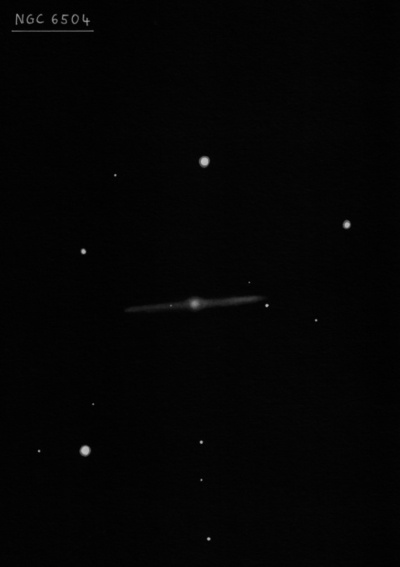
Albert Marth discovered NGC 6504 = m 358 on 27 Jul 1864 and noted "F, vmE, sbM, 2' l." His position is accurate.
300/350mm - 13.1" (6/18/85): fairly faint, small, pretty edge-on WNW-ESE, bright core, thin faint extensions. Located 22' SW of a mag 7 star.
400/500mm - 17.5" (8/1/89): moderately bright, edge-on E-W, sharp concentration, almost stellar nucleus. Situated between a mag 11 star 1.9' N and a mag 10.5 star 2.1' SE of center.
600/800mm - 24" (6/21/20): at 375x; fairly bright, large, very thin edge-on ~8:1 E-W, ~2.0'x0.25'. Contains a bright very elongated core and a nearly stellar nucleus. A mag 11 star is 2' SE and a slightly fainter star is 2' N. Located 20' SW of mag 6.9 HD 163948.
NGC 6504, located 28' NE, appeared fairly faint, moderately large, very elongated 3:1 NW-SE, 1.0'x0.3'. Unusual bowed or banana shape, concave outwards towards the west. The core seems offset towards the northwest side of the central region. Located in a rich star field with a mag 10.5 star 1.3' W.
Notes by Steve Gottlieb
NGC 6623
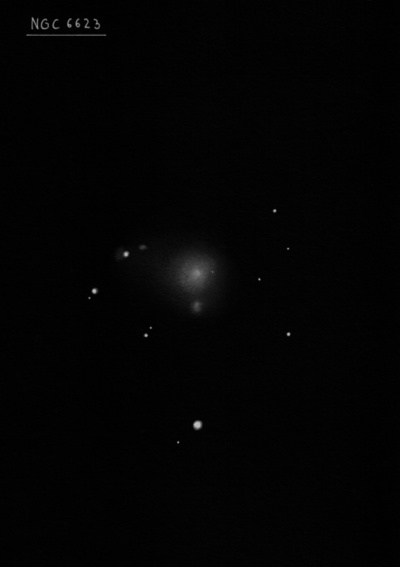
Albert Marth discovered NGC 6623 = m 377, along with NGC 6619, on 6 Jun 1864 and noted "pF, S, R, bM." His RA is 6 seconds too large. Kobold measured an accurate micrometric position in 1892 (published in 1907).
400/500mm - 17.5" (7/16/88): faint, fairly small, slightly elongated NW-SE, bright core, diffuse halo. Located 4.1' NW of mag 8.6 SAO 85932. Pair with NGC 6619 11.4' WSW.
600/800mm - 24" (7/15/15): fairly faint to moderately bright, moderately large, roundish, ~0.9' diameter, sharply concentrated with a very small bright nucleus. A mag 14 star is 45" NE of center. Resides in a rich star field 4.1' NW of mag 8.8 HD 168670. NGC 6619 lies 11' SW.
MCG +04-43-027 = PGC 61744 is at the south edge of the halo [27" S of center]. At 375x it appeared as an extremely to very faint knot, round, 12" diameter.
Notes by Steve Gottlieb
NGC 6580

Albert Marth discovered NGC 6580 = m 369 = Sf 31, along with NGC 6579, 6576 and 6577, on 7 Aug 1864 and noted "F, Dneb [with NGC 6579]." His position matches CGCG 142-022 = PGC 61566. Truman Safford rediscovered this galaxy on 6 Jun 1866 with the 18.5-inch Clark refractor at the Dearborn Observatory. CGCG misidentifies CGCG 142-020 as NGC 6579/6580. This error is mentioned in Malcolm Thomson's unpublished "Catalogue Corrections".
400/500mm - 17.5" (7/16/88): faint, small, elongated NW-SE, small bright core, diffuse halo. A mag 12 star is off the north edge. Forms a double system with NGC 6579 off the SW edge 34" from centers. Brightest in the cluster.
Notes by Steve Gottlieb
IC 4630
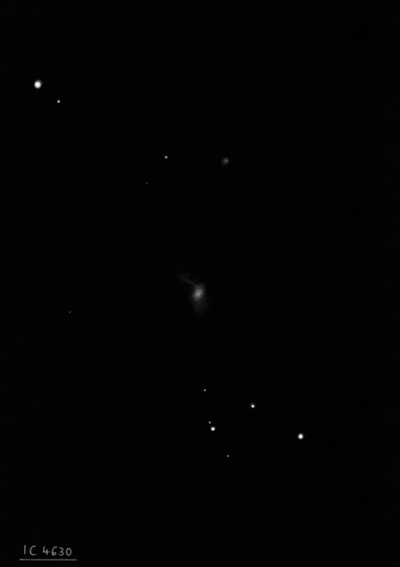
Stephane Javelle discovered IC 4630 = J. 3-1400 on 27 Jul 1903 with the 30-inch refractor at the Nice Observatory. He recorded "F, R, 20", stellar nucleus of mag 14." and measured an accurate position. VV 852 is the category of "Jets and Tails without Visible Cause"
400/500mm - 18" (7/12/10): faint, fairly small, elongated 3:2 ~N-S, 0.6'x0.4'. Sharply concentrated with a very small bright core. Forms the vertex of a flat isosceles triangle with a mag 10 star 4.4' SSW and another mag 10 stars a similar distance northeast.
600/800mm - 24" (6/30/16): at 322x; fairly faint/moderately bright, fairly small, slightly elongated N-S, 25"x20", very small bright core and stellar nucleus. I wasn't confident about seeing the tidal tail to the south. A mag 10 star is 4.4' SSW (brightest star in a small asterism) and another is 4.3' NE.
LEDA 1783536 was also picked up 6.6' ESE. It was extremely faint (V = 15.6), very small, round, 10" diameter, low surface brightness with no concentration. Situated 25" S of a mag 14.5 star and 1.6' W of a mag 13 star.
24" (7/14/15): at 375x, fairly faint, small, slightly elongated N-S, ~22"x16". Contains a bright stellar or quasi-stellar nucleus. I had a couple of definite "pops" of the tidal tail extending to the south.
24" (7/24/14): at 375x, this post-merger system appeared fairly faint, fairly small, slightly elongated N-S, 0.4'x0.3'. Strongly concentrated with a very small bright core containing very bright, sharp stellar nucleus. With careful viewing, there was a very strong impression of an extension (tidal plume) extending south. The narrow tidal tail extending northeast on the SDSS image was not seen.
Notes by Steve Gottlieb
NGC 6274
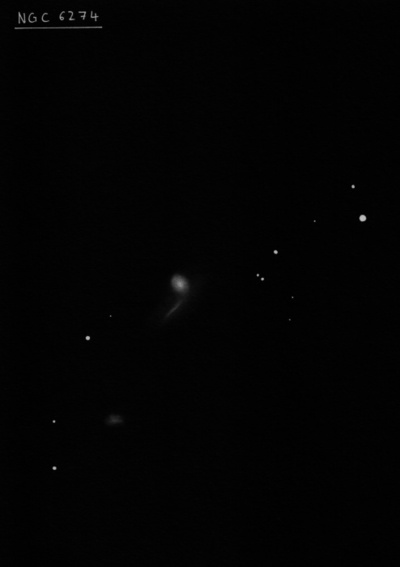
UGC 10643, which is identified as NGC 6274 in the RNGC and PGC, is located 21' NW. It appeared faint, small, possibly elongated E-W, brighter core. Located 2' E of an isosceles triangle consisting of three mag 13-14 stars. The nearest of these stars is a close double.
Albert Marth discovered NGC 6274 = m 326 on 28 Jun 1864 and noted "eF, vS." There is nothing close to his position.
RNGC and PGC identify UGC 10643 as NGC 6274. UGC 10643 is a double system (with PGC 59381) situated 11' north and 15 seconds of RA west of Marth's position, so it's a pretty poor match. Karl Reinmuth first gave this identification in his 1926 photographic survey "Die Herschel-Nebel".
UGC 10654 is a more likely candidate. It is situated 1.0 minute of time east of Marth's position, so is only off in one direction and a digit error would account for the error. Edward Fath suggested this identification in his 1914 paper "A Study of Nebulae", based on plates taken with the 60" at Mt. Wilson. Harold Corwin concurs with my suggestion that NGC 6274 = UGC 10654, particularly as NGC 6274 would be within 6' of NGC 6282, which Marth also discovered the same night.
400/500mm - 17.5" (7/1/89): faint, very small, slightly elongated N-S, weak concentration. A mag 15 star is off the southwest edge 19" from the center. Located 6' SSW of NGC 6282.
600/800mm - 24" (7/15/15): faint to fairly faint, small, slightly elongated N-S, 18"x12", small slightly brighter nucleus. A mag 15 star is just off the southwest side [20" from center]. Forms a pair with NGC 6282 6.2' NNE.
UGC 10643, which is identified as NGC 6274 in the RNGC, PGC, NED and SIMBAD is located 21' NW. At 225x and 375x it appeared faint to fairly faint, small, roundish, ~22"x18", small slightly brighter nucleus. UGC 10643b = MCG +05-40-020 is a very challenging galaxy (B = 16.5) attached on the south end. At 225x; UGC 10643b was occasionally visible as an extremely faint glow (too brief/faint for shape). At 375x I could tell it was elongated to the southeast when it popped.
Notes by Steve Gottlieb
NGC 6045
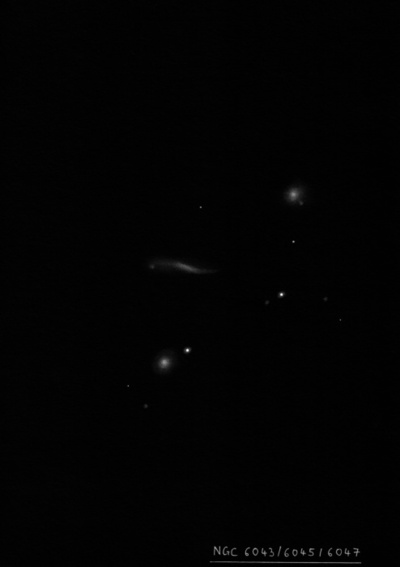
Lewis Swift discovered NGC 6045 = Sw. IV-24 on 27 Jun 1886, along with several other members of the Hercules Galaxy Cluster. He logged "eeF; vS; R; v diff; 6th of 10." and his position is 13 seconds of RA preceding UGC 10177 (a similar offset as NGC 6043). Bigourdan measured an accurate position in June 1888 (repeated in the IC 2 Notes).
300/350mm - 13.1" (5/14/83): very faint, elongated. Second of four in subgroup of AGC 2151.
400/500mm - 17.5" (5/13/88): very faint, small, very elongated 4:1 WSW-ENE. Located in the core of AGC 2151 between the NGC 6040/6041/6042 trio to the west and NGC 6050 3.8' E. The companion attached at the east end was not seen.
17.5" (3/23/85): second of a faint collinear trio. Very faint though slightly brighter than NGC 6043 1.9' NW and NGC 6047 1.7' S, though the nearby stars to these two galaxies was more eye catching.
600/800mm - 24" (6/4/16): at 322x; faint to fairly faint, very elongated 7:2 WSW-ENE, 45"x 12", slightly brighter elongated core. NGC 6045B was occasionally glimpsed at or just off the east end.
900/1200mm - 48" (5/15/12): fairly faint to moderately bright, edge-on 5:1 WSW-ENE, 1.0'x0.2', slightly brighter core. A very small companion is attached at the east end, dangling to the south perpendicular to the major axis. It appeared faint, small, elongated 2:1 N-S, 12"x6".
Notes by Steve Gottlieb
IC 1165
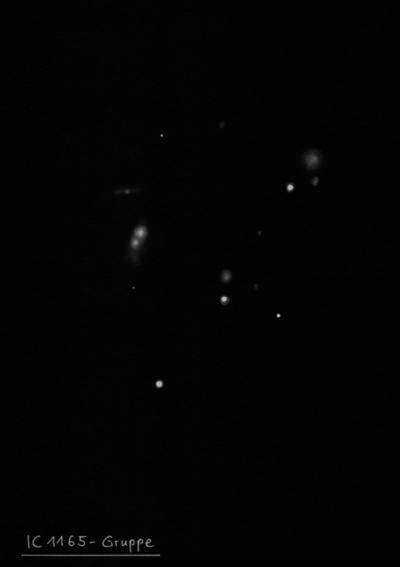
Stephane Javelle discovered IC 1165 = J. I-366, along with ICs 1155, 1157, 1160, 1161 and 1163, on 1 Aug 1891. His position matches CGCG 108-067 = PGC 56769, although CGCG (108-067) doesn't label this galaxy as IC 1165.
400/500mm - 17.5" (7/21/90): faint, fairly small, slightly elongated N-S, weak concentration. Three mag 13 stars almost collinear in a 3.5' string NW-SE located about 2' W. This is a merged double system that was not resolved. Forms a pair with MCG +03-41-50 1' NNE in AGC 2147.
600/800mm - 24" (6/13/15): at 375x; the brighter northwest component (VV 90a = PGC 56769) of IC 1165 appeared faint, very small, round, 18" diameter. The southeast component (VV 90b = PGC 56768) appeared extremely to very faint, very small, round, ~10" diameter. Both galaxies share a small common halo with the centers of this merged system separated by just 14"!
24" (6/28/14): at 375x and 500x, the main component (VV 90a) of this merged double system appeared fairly faint, small, round, 20" diameter, contains a stellar nucleus. The fainter companion (VV 90b) is attached at the south edge, and appears as a very faint, quasi-stellar knot [nucleus of the galaxy], ~5" diameter. Overall, the combined merged glow is ~30"x20", oriented NNW-SSE, containing two stellar nuclei. Member of AGC 2147.
VV 91a lies 1.8' SW and appeared extremely to very faint, round, just 6" diameter. Located just 21" NNW of a mag 12.9 star. The fainter companion (VV 91b) off the NE edge was not seen.
Notes by Steve Gottlieb
UGC 10310
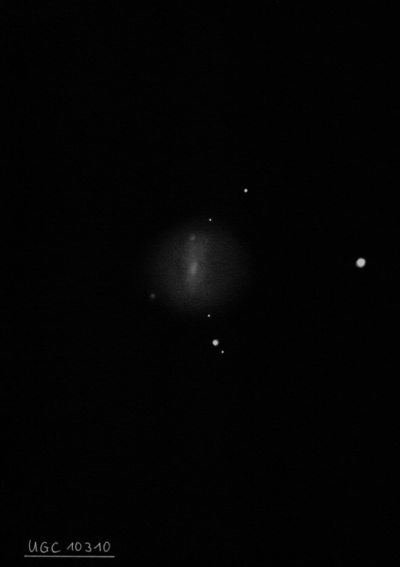
The DSS image reveals a face-on, knotty bar-like spiral with two extremely low surface brightness arms (see HST image).
400/500mm - 18" (7/10/10): at 175x, appeared as a very faint, fairly large, very low surface brightness glow, roughly 1.3'x1.0', with a very weak, broad concentration but no core. Located 11' E of mag 7.8 HD 146638.
Notes by Steve Gottlieb
UGC 11035
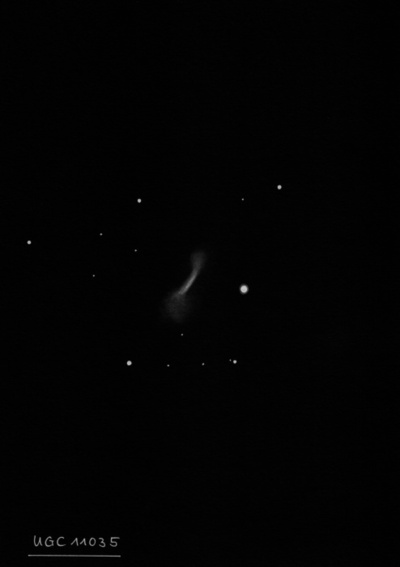
This galaxy is a mid-to-advanced stage major merger with two nuclei.
600/800mm - 24" (6/21/20): fairly faint, moderately large, very elongated 3:1 NW-SE, 1.0'x0.3'. Unusual bowed or banana shape, concave outwards towards the west. The core seems offset towards the northwest side of the central region. Located in a rich star field with a mag 10.5 star 1.3' W. NGC 6504 lies 28' NE.
Notes by Steve Gottlieb
IC 1182
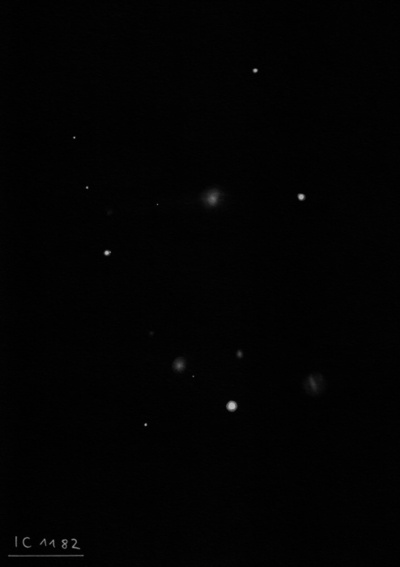
Stephane Javelle discovered IC 1182 = J. 1-372 on 11 Aug 1892. According to Harold Corwin in his Abell 2151 article, IC 1184 is a double or triple star 1.6' SE. The UGC questions if IC 1182 = IC 1184, which is does not.
400/500mm - 17.5" (5/13/88): very faint, very small, slightly elongated. Situated between two mag 14.5 stars 1.4' W of center and a mag 15 star following. Easier than IC 1183 2.1' SSE and NGC 6054 2.5' SW in AGC 2151. IC 1185 lies 5.4' SSE.
900/1200mm - 48" (5/5/16): at 488x; moderately bright, fairly small, slightly elongated ~E-W, contains a bright core that increases to the center. A mag 14 star is 1.3' W and a mag 17.8 star was occasionally visible [34"] east.
The brightest knot or condensation (likely a tidal dwarf galaxy) in the tidal tail was faintly visible 1.2' due east of IC 1182. It was generally visible as a very faint, small glow, slightly elongated E-W, ~10"x7". NED identifies this galaxy as IC 1182:[S72] d from the 1972 paper by Alan Stockton titled "Blue Condensations Associated with Elliptical and S0 Galaxies". This "knot" formed the western vertex of an obtuse isosceles triangle with a mag 17 star 40" NE and a mag 15 star 40" SE. The portion of the tidal tail extending directly out of IC 1182 (past the mag 17.8 star) was not seen.
48" (5/15/12): fairly faint to moderately bright, small, irregularly round, ~20" diameter, brighter nucleus. Located 1.4' E of a mag 14.3 star. Similar NGC 6054 lies 2.0' S. The jet extending out of the east side of the galaxy and the blue knots 1.2' E were not noticed (though not looked for).
Notes by Steve Gottlieb
UGC 10814
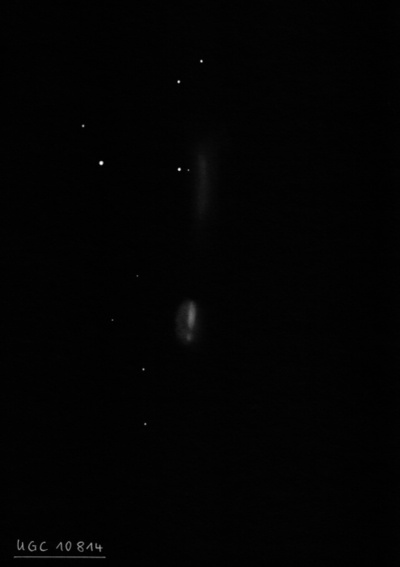
On the DSS extremely low surface brightness tidal tails extend several arcminutes to the north and south, with the dimmer southern tail heading to MCG +08-31-041.
400/500mm - 18" (7/11/10): Arp 102 appeared faint, fairly small, elongated 3:2 NNW-SSE, ~0.7'x0.45', broad weak concentration. A small group of stars is close north including a mag 11 star 2.6' NNE. MCG +08-31-041 lies 3.8' SSW. Located 12' WNW of mag 7.7 HD 157411. An extremely faint companion on the SSE end (MCG +08-31-042 = VV 10b) was not noticed.
Notes by Steve Gottlieb
UGC 10407
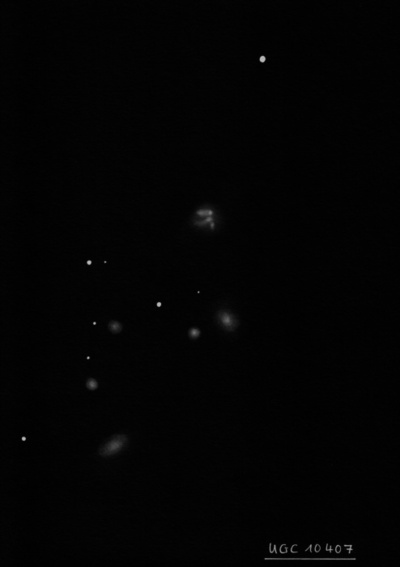
400/500mm - 17.5" (5/23/87): fairly faint, small, slightly elongated N-S. Second in a subgroup of four within AGC 2197.
Notes by Steve Gottlieb
UGC 10987
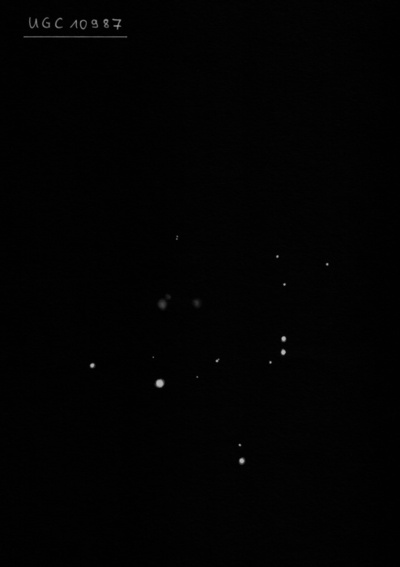
600/800mm - 24" (6/30/19): at 375x; this merged double system appeared faint to fairly faint, fairly small, elongated 3:2 ~E-W. Occasionally two very small nuclei were resolved. The third component (UGC 10987 NED1), just 0.5' W, appeared faint, very small, round, 12" diameter. CGCG 112-045 (brighter of a pair) lies 19' S.
24" (6/28/19): at 322x, 450x and 500x; fairly faint, fairly small, round, small bright core, occasional stellar nucleus. This is a double system and the companion appeared merged on the NW side and a few times sharpened to a knot, which was probably the nucleus. The third component is only 28" W and it was resolved as faint, very small, round, 10" diameter.
24" (7/14/18): at 375x; the merged eastern pair appeared faint to fairly faint, small, elongated 3:2 or 5:3 NW-SE, 20"x14". The glow was irregular and larger on the southeast side (the main component, UGC 10987 NED3 = LEDA 200349, of a 7" pair), but the northwest component (UGC 10987 NED2) was not resolved. A faint stellar nucleus was occasionally visible, offset to the southeast end (in LEDA 200349). The separate third member, UGC 10987 NED1, is 30" W and appeared faint, extremely small, round, 10" diameter, faint stellar nucleus.
24" (7/29/16): at 260x; UGC 10987 was resolved into a pair of close galaxies [separation ~25"]. The fainter western galaxy appeared very faint, extremely small, round, 8" diameter. The brighter eastern component is actually an extremely close pair itself [separation 7"]. It appeared as a faint to fairly faint glow (unresolved), slightly elongated, 0.3' diameter, even surface brightness. A mag 12 star is 1.2' S. Located 23' NE of mag 5.6 HD 161833.
Notes by Steve Gottlieb
NGC 6064_1
200/250mm - 8" (7/5/83): extremely faint, very small, at visual threshold.
300/350mm - 13.1" (7/5/83): faint, small, round, even surface brightness. In line with two mag 12/13 stars equally spaced.
400/500mm - 17.5" fairly faint, fairly small, oval ~N-S, bright core. Appears asymmetric as the galaxy is brighter on the west side. The POSS reveals this is an attached contact system (Arp 209). A mag 14.5 star is 1' W.
600/800mm - 24" (7/23/14): using 375x, moderately bright, fairly small, elongated 3:2 N-S, ~25"x18". Contains an extremely small nucleus that appears offset to the north side. The eastern component is merged, except for a small, thin extension that juts out to the south on the southeastern side. A mag 15 star lies 0.8' W.
24" (6/28/14): at 375x, appeared fairly faint, fairly small, elongated 3:2 N-S, 30"x20", contains a quasi-stellar nucleus and mottled core that is slightly displaced to the north side. The two components were not clearly resolved.
900/1200mm - 48" (4/5/13): the main glow of this disrupted system or merger appeared fairly bright, fairly small, slightly elongated, irregular or mottled. The glow brightens along the eastern side and very thin, faint extensions protrude along the eastern side to the north and south (more prominent on the south end). The appearance is similar to an edge-on galaxy attached to the larger, mottled western component.
48" (5/15/12): at 488x, the disrupted system NGC 6052 = Arp 209 had a very strange appearance. Attached on the southeast side is a faint, elongated glow, ~22"x6", extending out from the main portion of the system and giving the strong impression that an edge-on galaxy was involved in this merger. Also on the northeast side, a fainter and broader extension or plume was visible oriented N-S. Although these two features seemed detached, they may be part of the same partially merged galaxy. To the west of these extended features is the most prominent region or core of the galaxy, which appeared bright, irregular round and mottled. The halo was very irregular in shape and brightness, particularly on the west side which had a mottled, tattered appearance.
Notes by Steve Gottlieb
Hu 2-1
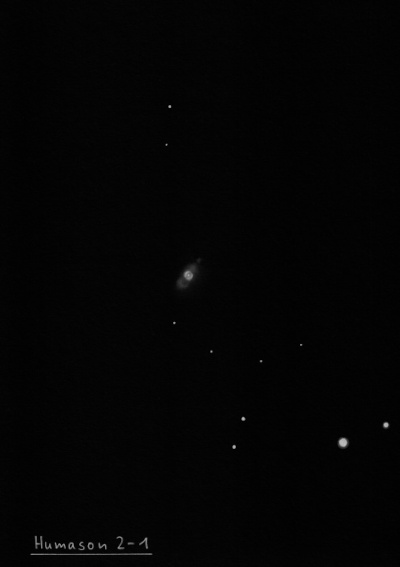
| Type | PN |
| RA | 18:49:47.6 |
| Dec | +20:50:39.0 |
| major_axis | 18.0'' |
| mag | 11.6 |
| surface_bright | 4.8 |
Vy 1-2
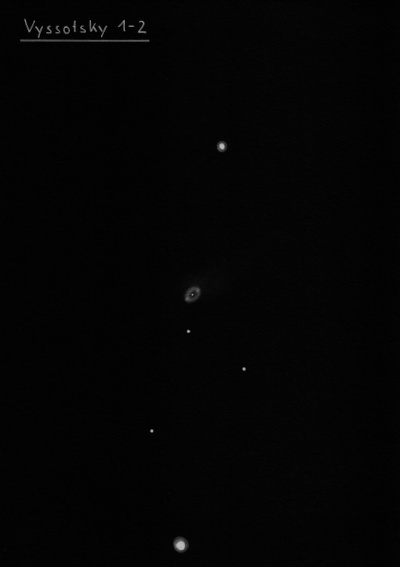
| Type | PN |
| RA | 17:54:23.0 |
| Dec | +27:59:58.0 |
| minor_axis | 54.0'' |
| mag | 12.0 |
| surface_bright | 6.1 |
HCG 82
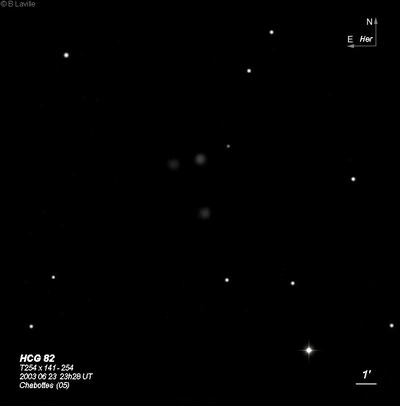
| Type | GALCL [E2] |
| RA | 16:28:22.1 |
| Dec | +32:49:25.0 |
| major_axis | 4.0' |
| mag | 12.2 |
| surface_bright | 99.9 |
Abell 2199
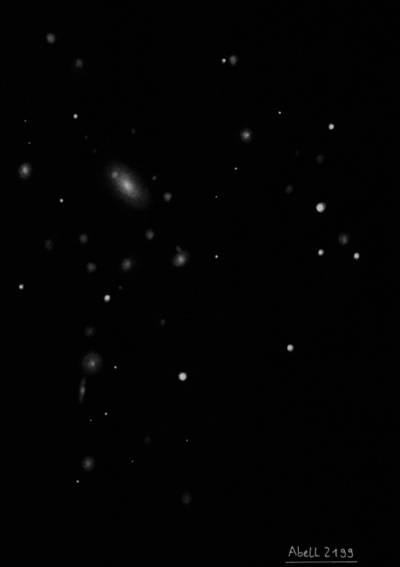
| Type | GALCL [21I] |
| RA | 16:28:36.0 |
| Dec | +39:31:00.0 |
| major_axis | 89.6' |
| mag | 13.0 |
HCG 81
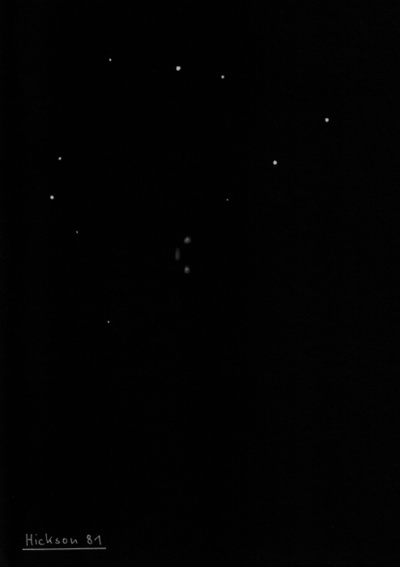
| Type | GALCL [E3] |
| RA | 16:18:13.0 |
| Dec | +12:47:39.0 |
| major_axis | 72.0'' |
| mag | 13.3 |
| surface_bright | 99.9 |
Abell 39
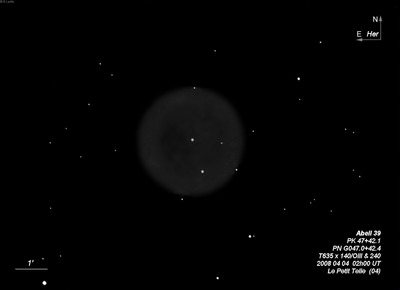
| Type | PN [2c] |
| RA | 16:27:33.7 |
| Dec | +27:54:33.0 |
| major_axis | 2.9' |
| mag | 13.7 |
| surface_bright | 15.8 |
Abell 2151
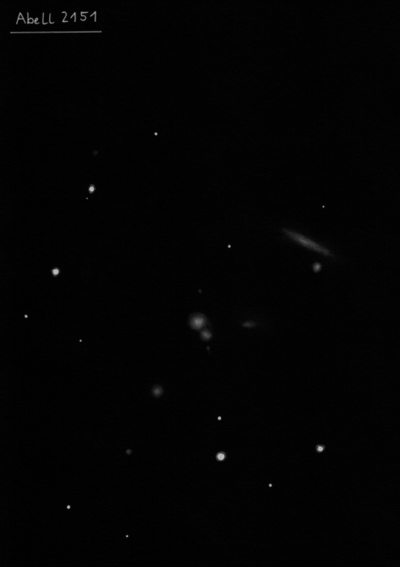
| Type | GALCL [21III] |
| RA | 16:05:06.0 |
| Dec | +17:43:00.0 |
| major_axis | 56.0' |
| mag | 13.8 |
HCG 83
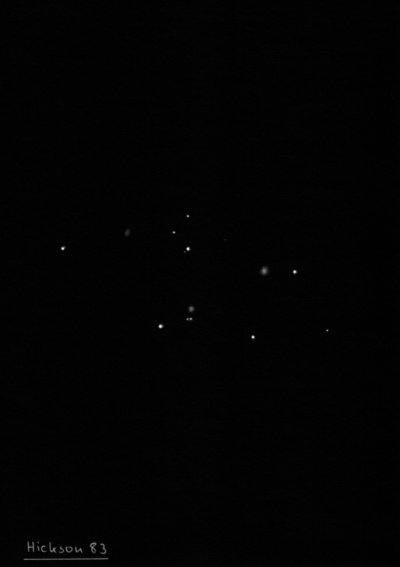
| Type | GALCL [E3] |
| RA | 16:35:40.9 |
| Dec | +06:16:12.0 |
| major_axis | 2.5' |
| mag | 13.8 |
| surface_bright | 99.9 |
Sa 4-1
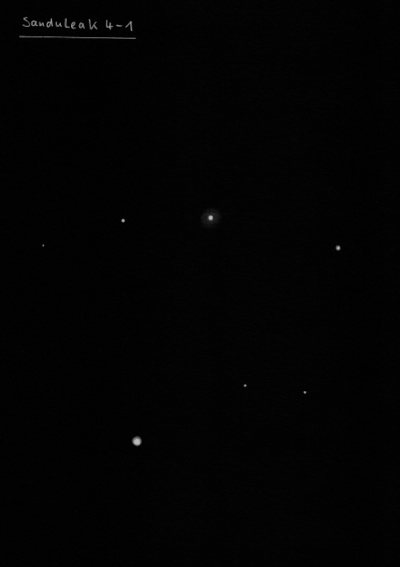
| Type | PN |
| RA | 17:13:50.4 |
| Dec | +49:16:11.0 |
| major_axis | 18.0'' |
| mag | 14.3 |
| surface_bright | 11.8 |
Pal 14
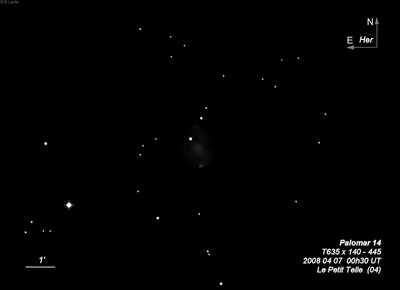
| Type | GC |
| RA | 16:11:00.0 |
| Dec | +14:58:00.0 |
| major_axis | 2.5' |
| mag | 14.7 |
| surface_bright | 16.4 |
UGC 11301
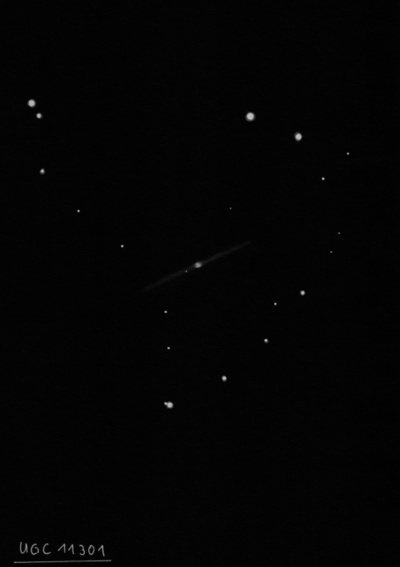
| Type | GX [Sc] |
| RA | 18:37:54.5 |
| Dec | +17:32:02.0 |
| major_axis | 2.0' |
| minor_axis | 24.0'' |
| position_angle | 109.0 |
| mag | 14.9 |
| surface_bright | 14.9 |
